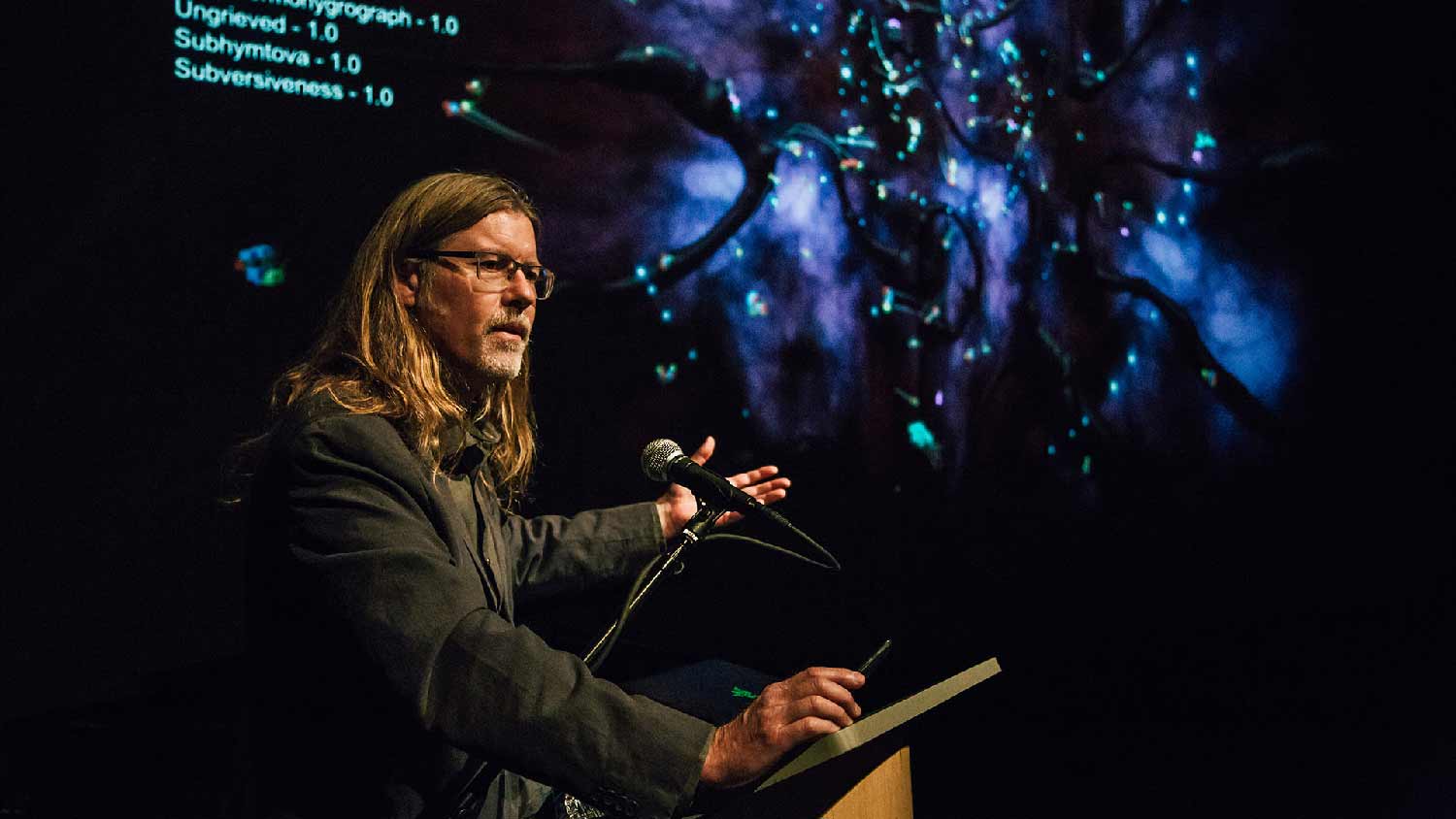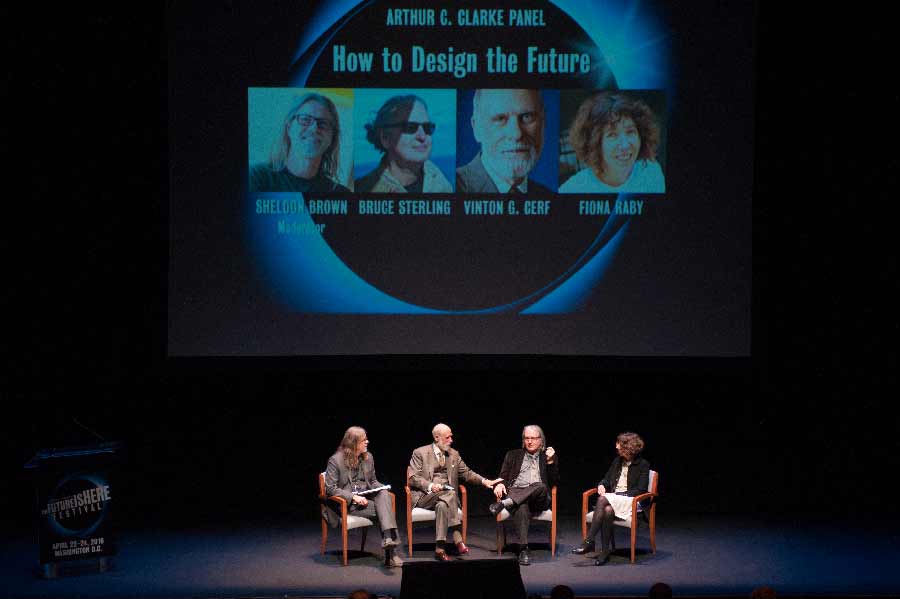Published Date
Share This:

Clarke Center Director Sheldon Brown discusses a shared virtual reality environment called Assembly. Photo courtesy of the Clarke Center
UC San Diego’s Arthur C. Clarke Center for Human Imagination Takes Audiences to Places They Can’t Wait to Get to
UC San Diego’s Arthur C. Clarke Center for Human Imagination is looking to the future. With its own brand of “speculative culture,” the Clarke Center integrates the arts, sciences, humanities, engineering and medicine to better understand, enhance and enact the outcomes of human imagination. It considers the modes from which imagination operates: neurological, cognitive and socio-cultural. Public programs are a key medium for exploring and presenting unique perspectives on these forms of imaginative thought. One example of the type of programs the center offers is its upcoming visit by the famed mathematician and physicist Sir Roger Penrose, known for his rigorously unorthodox theories, June 5, 6:30 p.m., in the Hojel Auditorium, at the Institute of the Americas. Another example is the recent public discussion between two celebrated science fiction and fantasy novelists: George R.R. Martin and Kim Stanley Robinson.
“Speculative Culture is a deliberate charge for our cultural forms to help attenuate understanding to the rapid and profound changes confronting humanity—integrating the prototypical stance of new media art, the propositions of design and the vision of science fiction,” stated Sheldon Brown, Clarke Center director and professor in the UC San Diego Department of Visual Arts, who holds the John D. and Catherine T. MacArthur Foundation Endowed Chair in Digital Media and Learning. “These forms of culture each provoke consideration of what is to come. Speculative culture combines these previously distinct activities to further the depth and impact of art and design on cultural development at large.”
According to Brown, the Clarke Center’s most significant work has been using emerging methods of computational neuroscience and human behavior analysis to identify components of imagination in action as interactive elements in digital media experiences.
“We have taken early examples of this work and developed exhibits that have been shown at places such as the World Future Society in Washington, D.C.,” said Brown. “We've also furthered research into areas of science fiction studies, such as helping bring together a network of scholars studying the work of Octavia Butler, which is looking to be a significant approach to how science fiction provides insight into complex issues of our time.”
In fact, the Clarke Center focuses on science fiction and fantasy because these genres stretch the imagination about what choices we make, individually and culturally.

Left to right: Sheldon Brown, Vint Cerf (vice president and Chief Internet Evangelist, Google), Bruce Sterling (cyberpunk author and design theorist) and Fiona Raby (design critic) speaking at the Future is Here Festival. Photo courtesy of the Clarke Center
“Our work with the science fiction and fantasy community not only stretches our consideration about the possibilities that we may choose to pursue or avoid for ourselves and our world, but also to engender ‘the creation of creativity’ which may be the ultimate value that the arts provide to our species,” explained Brown.
The hallmark of the Clarke Center’s public programming is the world-renowned Clarion Science Fiction and Fantasy Writers’ Workshop. It is the oldest writing program of its kind, known to produce more of today's notable science fiction writers than any other university in the world. For example, recent Clarke Center guests Martin and Robinson are Clarion instructorand student-alumni.
Besides Clarion, the Clarke Center hosts many diverse public programs such as the recent humanities/science-focused “Entanglements: Rae Armantrout and the Poetry of Physics.” It convened a conversation between the Division of Arts and Humanities’ Pulitzer-Prize-winning poet Armantrout, critic Amanda Glaser, poet Brandon Som and the Clarke Center’s cosmologist Brian Keating. The program highlighted what poetic engagement with physics can teach those working in the physical sciences, and vice versa. Another inventive program is a monthly podcast called Into the Impossible—a collection of stories, ideas and speculations shared between visionaries from the artistic, scientific, humanistic, engineering and medical worlds.
According to Brown, who also serves as the site director of the National Science Foundation-Sponsored Center for Hybrid Multicore Productivity Research, the Clarke Center’s film series over the years has proven popular with audiences. This public program screens notable science fiction movies and features panelists who discuss the films’ scientific basis, social impact and cultural achievements.
“We often invite people who were involved in the making of the movie as part of this series. For instance, we screened ‘Close Encounters of the Third Kind’ and hosted Richard Dreyfuss in conversation with science fiction author David Brin, our scholar-in-residence,” Brown said. “We held the San Diego premier of the film ‘Arrival,’ with the Ted Chiang, author of its original short story. And, we screened ‘2001: A Space Odyssey,’ with the Keir Dullea, the actor who played Dave, and Fred Ordway, the science adviser for the movie.”
With its future-focused perspective, the Clarke Center envisions program and research opportunities in combining the emerging methods of machine intelligence with the developing understanding of cognitive states to accelerate the processes of imagination and creativity.
“As we do this, we also look to better understand the methods of imagination that humanity has developed over its history, such as narrative and the scientific hypothesis, and how these can further develop to be most relevant to our human condition,” said Brown. “We are guided by the legacy of Arthur C. Clarke, and our goal is to continue to be a source of inspiration and action; to make the future a place we can't wait to get to.”
Share This:
Stay in the Know
Keep up with all the latest from UC San Diego. Subscribe to the newsletter today.



